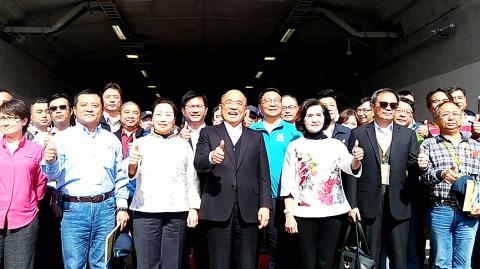Safer and faster road travel in eastern Taiwan became a reality yesterday with the official opening of the improved Suhua Highway connecting Yilan and Hualien counties, shortening travel time between the two counties from almost 160 minutes to 100.
Premier Su Tseng-chang (蘇貞昌) told the inauguration ceremony that the government would continue to enhance road safety on sections not covered by the improved highway.
The upgraded road bypasses the most dangerous parts of the old highway, mostly through the use of tunnels, which account for more than 60 percent of the new road, the Ministry of Transportation and Communications said.

Photo: Chiang Chih-hsiung, Taipei Times
The 38.8km project covers three sections: from Suao (蘇澳) to Dongao (東澳) townships in Yilan County; from Yilan’s Nanao Township (南澳) to Heping Township (和平) in Hualien County; and from Hejhong (和中) to Dacingshuei (大清水) in Hualien.
The first stretch opened on Feb. 5, 2018, and the second and third sections opened yesterday.
As the improved highway allows for a reduction of one hour in travel time between Yilan and Hualien counties, tourism industry operators in Hualien expressed hope the improved highway will boost tourism in the county.
Hualien Hostel Association director Chen Ping-chung (陳秉忠) said he hopes tourism numbers increase by 30 percent in the coming year, and said industry revenue could increase by as much as NT$6.6 billion (US$219.2 million).
Accommodations providers were seeing a 90 percent occupancy rate for the Lunar New Year holiday later this month, and they hoped to reach full occupancy before mid-February, he said.
However, Hualien Tourism Hotel Trade Association director Kao Shui-lu (高水祿) said occupancy rates varied by hotel, with some reporting only 70 percent occupancy for the first four days of the holiday, which begins on Jan. 24, and others reporting 80 to 90 percent occupancy.
He hoped the highway would bring more tourists into Hualien in the future, Kao said.
Yilan accommodations providers are concerned they will be marginalized as tourism to Hualien increases, with many citing as an example the reduction of tourism in New Taipei City’s Pinglin District (坪林) after improvements to the Chiang Wei-shui Memorial Freeway (Freeway No. 5) made areas further south more accessible.
Whether tourism in Yilan would be affected would require looking at how traffic jams develop on the Suhua Highway, Yilan Association of Tourism director Wang Wen-hsin (王文新) said.
In the past, travelers from Taipei would spend a night in Yilan and then a night in Hualien before heading home, but with the improved road, they might instead opt to spend two nights in Hualien, or even travel to Taitung, he said.
However, if traffic jams occurred on the highway they may simply do as they did in the past and stay for a night in Yilan, he said.
Yilan would attempt to offset possible losses by marketing the county’s special characteristics, and would also attempt to attract visitors with deals on accommodations, Yilan County Business and Tourism Department Director Lee Tung-ju (李東儒) said.
Yesterday also saw the start of the first direct daily bus service between greater Taipei and Hualien, with buses departing every 20-30 minutes from Taipei’s Nangang District (南港) and New Taipei City’s Banciao District (板橋).
The trip would take an average 3.5 hours one way and cost NT$320 to NT$352, the ministry said.

The Ministry of Foreign Affairs (MOFA) yesterday said it is closely monitoring developments in Venezuela, and would continue to cooperate with democratic allies and work together for regional and global security, stability, and prosperity. The remarks came after the US on Saturday launched a series of airstrikes in Venezuela and kidnapped Venezuelan President Nicolas Maduro, who was later flown to New York along with his wife. The pair face US charges related to drug trafficking and alleged cooperation with gangs designated as terrorist organizations. Maduro has denied the allegations. The ministry said that it is closely monitoring the political and economic situation

Conflict with Taiwan could leave China with “massive economic disruption, catastrophic military losses, significant social unrest, and devastating sanctions,” a US think tank said in a report released on Monday. The German Marshall Fund released a report titled If China Attacks Taiwan: The Consequences for China of “Minor Conflict” and “Major War” Scenarios. The report details the “massive” economic, military, social and international costs to China in the event of a minor conflict or major war with Taiwan, estimating that the Chinese People’s Liberation Army (PLA) could sustain losses of more than half of its active-duty ground forces, including 100,000 troops. Understanding Chinese

UNRELENTING: China attempted cyberattacks on Taiwan’s critical infrastructure 2.63 million times per day last year, up from 1.23 million in 2023, the NSB said China’s cyberarmy has long engaged in cyberattacks against Taiwan’s critical infrastructure, employing diverse and evolving tactics, the National Security Bureau (NSB) said yesterday, adding that cyberattacks on critical energy infrastructure last year increased 10-fold compared with the previous year. The NSB yesterday released a report titled Analysis on China’s Cyber Threats to Taiwan’s Critical Infrastructure in 2025, outlining the number of cyberattacks, major tactics and hacker groups. Taiwan’s national intelligence community identified a large number of cybersecurity incidents last year, the bureau said in a statement. China’s cyberarmy last year launched an average of 2.63 million intrusion attempts per day targeting Taiwan’s critical

‘SLICING METHOD’: In the event of a blockade, the China Coast Guard would intercept Taiwanese ships while its navy would seek to deter foreign intervention China’s military drills around Taiwan this week signaled potential strategies to cut the nation off from energy supplies and foreign military assistance, a US think tank report said. The Chinese People’s Liberation Army (PLA) conducted what it called “Justice Mission 2025” exercises from Monday to Tuesday in five maritime zones and airspace around Taiwan, calling them a warning to “Taiwanese independence” forces. In a report released on Wednesday, the Institute for the Study of War said the exercises effectively simulated blocking shipping routes to major port cities, including Kaohsiung, Keelung and Hualien. Taiwan would be highly vulnerable under such a blockade, because it